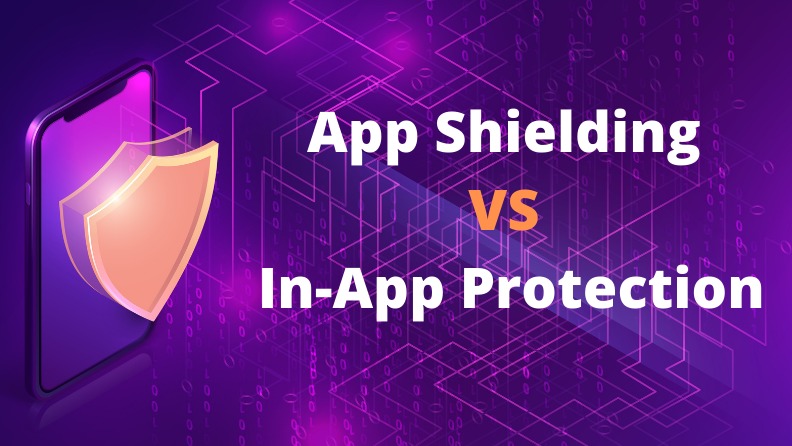
Most app developers know that mobile devices have become the primary target for attackers these days. According to a 2019 report by the tech firm Check Point, attacks on smartphones and other mobile devices grew by a staggering 50 percent compared to the previous year. The developer community knows that even the tiniest of vulnerabilities in an operating system or app code can prove costly to the app-owning company. Once a hacker breaks in, they can access the user’s private data, steal bank passwords, and even carry out fraud financial transactions.
To avert any major attacks, app developers use methods like application shielding and in-app protection. Below we discuss how these two methods are different and what their comparative advantages are.
App Shielding
While most security mechanisms monitor, detect and test loopholes in applications, app shielding tries to avert any potential attack by making the codes difficult to decipher. This is a major deterrent for most attackers, as finding an entry point becomes an arduous task. App shielding analyzes the environment of the application to understand its threat-handling capacity and beefs up the security. App shielding is a proactive method of strengthening app security, as it makes reverse engineering of the code harder. It can be compared to the CCTV cameras installed at your homes or office establishments. It does not make your premises impenetrable, but it will certainly keep a majority of mischievous entities at bay.
Developers employ multiple ways to shield apps from common attacks. Some of them are:
- Code obfuscation: Obfuscation is a process of making something difficult to comprehend. The code of particular programs is obfuscated to make life difficult for hackers who try to reverse-engineer the software application. Obfuscation can be carried out by encrypting certain parts of the code, renaming metadata, renaming vital variables to render them meaningless, or even by injecting misleading code to the application binary. Apart from these methods, developers tend to manipulate code to make it difficult for potential attackers to keep track without making any structural changes to the app.
- White-box cryptography: These are activities carried out to safeguard sensitive app data stored on the mobile device. On an open device, the keys used for carrying out transactions are detectable and modifiable, making the app vulnerable to attacks. White boxing helps in averting such attacks by obfuscating these keys by storing them in the form of data and code. The process makes it hard for any potential attacker to find the original key despite the cryptographic algorithms being available and open to modification. White-boxing techniques are similar to obfuscation but may also use additional anti-tampering methods to derive the desired result.
- Anti-tampering: It is a process that involves various methods, like obfuscation, encryption, and protection of checksum and hashcodes. Obfuscation aims to make code difficult to decipher. Anti-tampering techniques make it tougher for miscreants to breach the defense wall on the obfuscated code.
In-App Protection
In simple terms, in-app protection is the internal defense system of an application. It detects any malicious activity and automatically initiates the process of neutralizing the attack. Unlike app shielding, it detects malware and network and operating system attacks in real-time. In-app protection safeguards the backend system from malware attacks and device vulnerabilities. Here are a few real-time threats that in-app protection can detect and handle:
- Malware: Real-time detection within the app can find and weed out several types of malware and suggest corrective measures. The increasing user base of smartphones has made this medium a lucrative target for attackers. Malware, such as RATs, Monokle, Anubis, and Cerberus, are increasingly appearing on mobile devices. It is a trend that is bound to continue as all organizations are branching out services through mobile devices. RATs keep track of password entries and clipboards to gather as much data on the user as possible.
- Zero-day detection: A zero-day exploit tries to take advantage of vulnerabilities that app developers are not aware of. In-app protection detects viruses that cause damage through operating system behaviors. Zero days are found by closely monitoring any hints of compromise as opposed to scanning a library of known exploits.
- Network or Wi-Fi mitigation: In-app protection detects the man-in-the-middle (MiTM) attacks and network connection threats. An application should be equipped to detect SSL stripping and any bid to decrypt users’ app traffic to neutralize the attack.
- Device configuration risk: Several factors contribute to the risk exposure of endpoints, and a lot of it stems from users being administrators of their devices. They may be lax in following the necessary protocols, such as installing regular updates. In-app protection gives the developer an insight into the risk profile of the user. This information helps them formulate conditional access policies for their apps.
App shielding and in-app protection are both vital tools employed to protect an app. In a lot of cases, developers may require to utilize both the strategies in the application to make it resilient and extract device attack data. Developers spend countless hours carrying out standard security protocols, such as static code analysis, app shielding, authentication, and cryptography, but they underestimate the importance of securing the app’s runtime environment. Mobile applications bank on the operating system to facilitate safe functioning. If a device is damaged, the application system is adversely affected as well. Mobile apps with real-time protection can detect malware on its own without relying on the device’s default security features. The autonomous detection eliminates threats in the real-time, making transactions and data on the app safer. Therefore, depending on the target audience, developers need to employ a mix of features from both these strategies to secure their apps.